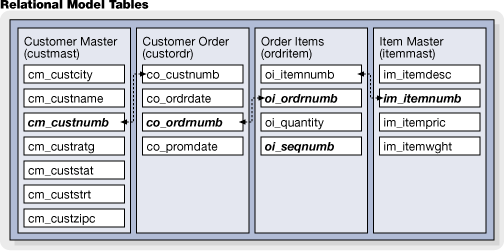drivers\csharp.sql.ado.net\tutorials\CSharpTutorial2.cs
Now we will build some table/file relationships using the FairCom DB ADO.NET Data Provider using C#.
This tutorial will advance the concepts introduced in the first tutorial by expanding the number of tables. We will define key columns/fields and create specific indexes for each table to form a relational model database.
Like all other examples in the c-tree tutorial series, this tutorial simplifies the creation and use of a database into four simple steps: Initialize(), Define(), Manage(), and You’re Done() !
Tutorial #2: Relational Model and Indexing
Here we add a bit more complexity, introducing multiple tables, with related indices in order to form a simple "relational" database simulating an Order Entry system. Here is an overview of what will be created:

Note our simple Main() function:
using System;
using System.Collections;
using Ctree.Data.SqlClient;
namespace CSharpTutorial
{
class Tutorial2
{
// declare connection, command and reader objects
static CtreeSqlConnection conn;
static CtreeSqlCommand cmd;
static CtreeSqlDataReader rdr;
//
// main()
//
// The main() function implements the concept of "init, define, manage
// and you're done..."
//
static void Main()
{
Initialize();
Define();
Manage();
Done();
Console.Write("\nPress <ENTER> key to exit . . .");
Console.ReadLine();
}
We suggest opening the source code with your own editor.
![]() Continue now to review these four steps.
Continue now to review these four steps.